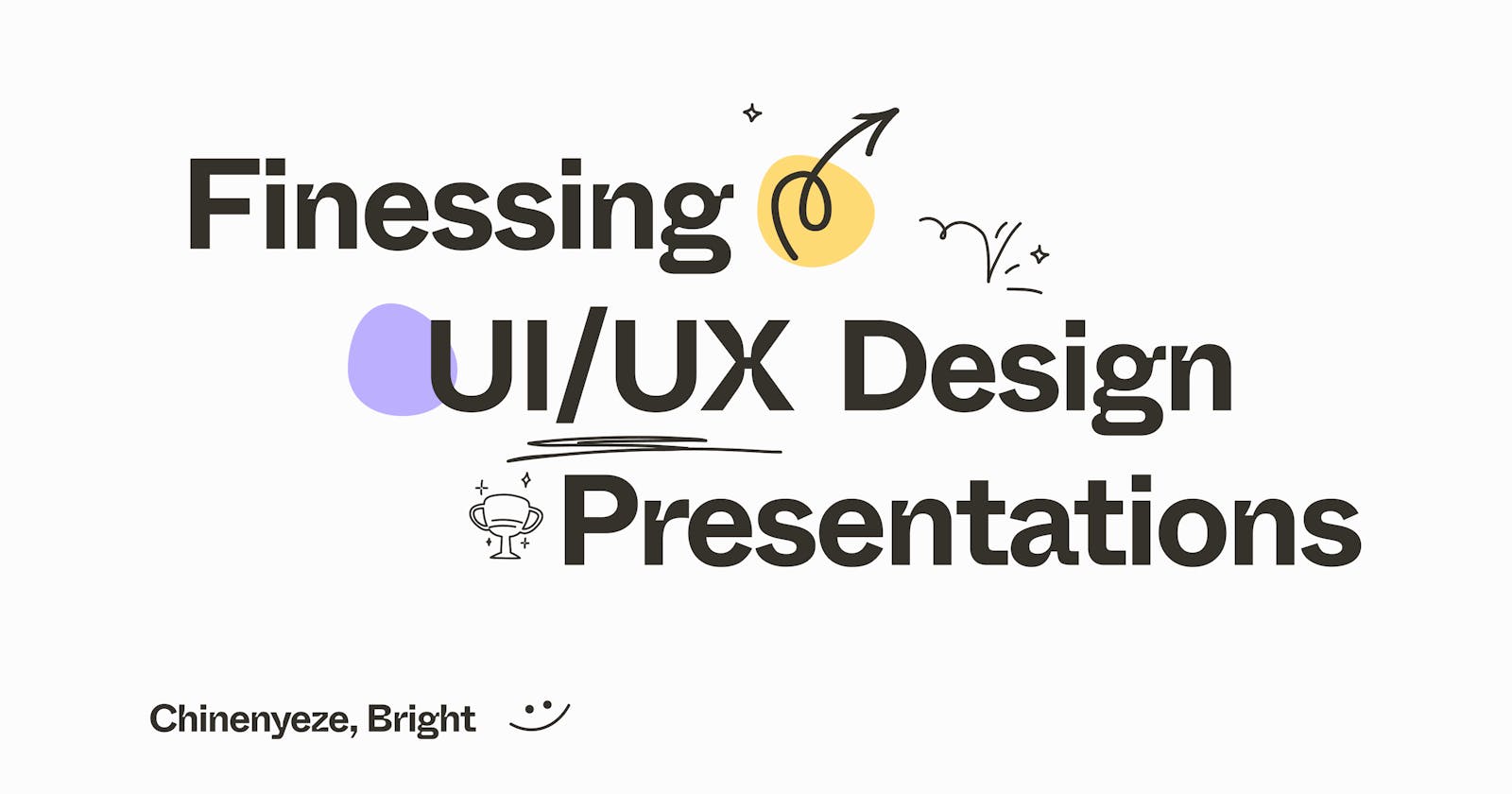Finessing UI/UX design presentations
Tips, guidelines & editable files to aid effective design presentations
Introduction
Have you ever imagined what occurs in an art gallery with a wall covered with large abstract paintings? Several people, including art lovers, nod in appraisal, make comments and opinions while applauding these work of art. How do you know it's any good, though? How do you know the artist is a genius rather than a fluke or a mere coincidence?

For many non-creatives, this is how it feels. You want to believe in the people around you, but you can't make decisions for yourself. You may be able to say whether you like or dislike something, but you have no idea why. It's one thing to have a good idea but being able to present it is a different story. Architects also show stakeholders a prototype when presenting a proposed building. They describe the building's materials, how tall the floors are, where the morning and afternoon sun will shine, how much parking there is, how many offices there are, how many elevators there are, how many people can fit on a floor, and how the interior of the building will make the residents feel, among other things. I once heard from a cousin that the majority of presenting architectural ideas is about trust, and I believe the same is true for interface design. The more your audience or stakeholders believe in you, the easier and faster your presentations will become.
"Present your work just like an architect"
Follow this link to a Figma community file with editable sample slides on UI/UX design presentation
https://www.figma.com/community/file/1113471194516818484
Most creatives think of hard skills like design, problem-solving, analytics, research, prototyping, UX writing, or even coding when they first consider a job in UI or UX design. While these are crucial core abilities for working as a UI/UX designer, it's also important to build presentation and communication skills. To effectively bring ideas, concepts, and design information to life, presentation abilities are used. Presentation abilities can help you advance as a UI/UX designer in a variety of ways, including slide decks, portfolio presentations, sharing design iterations, and presenting final designs. In this article, we will cover:
Before presenting: Preparation mood, getting ready
During Presentation: The journey through your work and showcasing your efforts.
Ending your Presentation: achieving effective communication, making a lasting impression, and commanding results.
Before presentation
Preparing for presentations should begin immediately at the inception of the project, with the first notion or stroke of the pen to create the first sketch. A few methods that might help you enhance your presentation skills include planning strategically for research documentation and audience engagement, as well as preparation and planning for a good mentality. Here are some helpful hints:
Engage Stakeholders: Constant updates and feedback sessions.
Try to incorporate your stakeholders from the start, this will help you to bounce ideas and concepts off them informally throughout the design process. This means a daily bot-assisted stand-up message with a link or an image containing the fresh concept or strategy in my instance. This also allows me to get feedback faster and saves everyone's time. I then present concepts to the stakeholders for a second time after every two weeks or design sprint(s) to acquire an official consensus before the designs are transferred for development. One benefit of this approach is that stakeholders will be better able to state they don't like a specific element rather than the entire design.
Make your presentation goal clear
Spend some time thinking about what you want to accomplish with your presentation. Do you have your portfolio on display for a potential employer? Are you attempting to persuade a top executive or a potential client to test a fresh design concept? Are you keeping your stakeholders up to date on the newest study findings? Working backward from your core goal, map out the presentation structure and the most important elements you want to convey.

Master your material
Take time to reflect on the topic matter of your presentation before giving it to an audience. This may seem obvious but when giving a presentation, a lack of expertise can cause anxiousness and embarrassment. It can also affect your reputation if you are unable to respond to simple follow-up questions. Although no one can claim to be an expert in every field, if you get a question you can't answer, be open and honest about it: "I'm not sure, but I'll get back to you on that!" This will help your audience respect and trust you.
Know Your Audience
There will be certain presentations where you have no idea who will be in attendance or what their sensitivity or tech-savviness is, but for the most part, you will know the exact attendance list as well as everyone's position in the meeting well in advance. Given this, it would be unwise not to personalize your presentation in a manner feasible and appropriate. This can be a combination of using terminology or analogies that are unique to them or recounting procedures in a way that connects with them and their background.

Always Make a presentation outline:
Creating a presentation outline helps you properly organize your thoughts and the flow of the presentation; it also centralizes content for sharing after the review, which is likely a format that stakeholders are familiar with, and it demonstrates that you've put time and effort into the project. For simple tasks, here's a general outline you might want to follow:
- Welcome Address
- Agenda
- Project Objectives
- Images and a link to your design (often a prototype)
- Questions and feedback
- Recap
- Next steps
- Finalize, thanks.
Practice your delivery flow.
It is critical to prepare for your presentation by practicing how you will speak about your work. You might want to practice in front of the mirror at home or with a few trusted colleagues or friends. When something is said aloud, it often feels and sounds different from when it is read in your head. Recording and listening to these practice sessions can also be quite beneficial. You might be astonished at how different you sound and speak from how you thought you did. Another advantage of practicing is that you can plan out your presentation's timing ahead of time. Almost every presentation has a time limit, so make sure you leave adequate time for feedback and critique by properly scheduling your presentation.

Maintain a positive outlook.
Confidence develops over time. You should have a solid, interesting presentation-ready materials at this point. You've gone over it several times and are certain you've absorbed the knowledge. It's now time to fight the nerves and focus on developing a calm, confident mindset. Before your presentation, make sure you have enough rest. Meditation, breathing exercises, listening to music, or even conversing with friends are all things that might help you feel more optimistic.

During presentation
A trip through your design presentation Take the stakeholders step by step through your thought process and ideas, explaining why you took each decision. Break it down into little bits and help them make the same choices you did. When you show someone something complicated, they have a hard time judging it. Imagine a housing agents pitch to you during an apartment search is:
"This is an excellent apartment. It would be good for you"
Alternatively,
"This apartment, although small, is located in one of the best estates in town. It has a dedicated elevator, 2 bedrooms, adjustable wardrobes and cabinets, a Jacuzzi, and a balcony. Its windows give you a lovely city view and a heart-melting sunset view in the evenings. Very friendly and calm neighbors and is just a 5minutes drive from the city center. You could certainly do somewhere fancier for your money, but if you like comfort and class, this place is probably excellent for you."
Can you see how it was broken down into various offers and features in the second example? And how certain features might be useful in some situations but not others. As a result, convey your views in this manner. Discuss the features and individual components. It may appear to take longer, but it will help you create trust with your audience and stakeholders, allowing you to complete tasks more quickly in the future.
Speak Calmly
When you're talking someone through your project, go a little below the cadence that seems natural to you. Remember that your audience isn't as knowledgeable about the subject as you are. What you think is typical is almost probably too fast. Inhale deeply. Take it easy. Boldly, deliberately, and slowly lead your audience through each page of your slide presentation.

Every viewpoint is valid and beneficial.
Unfortunately, some designers approach interactions with the assumption that stakeholders will not provide useful input. This prevents you from gaining crucial insights that could improve your work. Always have an open mind when receiving input, and remember that every one of your stakeholders brings a distinct viewpoint to the table. Do your homework and figure out why they're making those observations. Because your stakeholders may lack the vocabulary to express technical design input, you must demystify and encourage them to do so.
Encourage audience involvement.
You should spend time thinking about new techniques to engage your audience in order to give excellent presentations. Ask for opinions with direct questions, and educated assumptions to get your audience to think about what you're saying. At the very least, a show of hands ("how many of you have wondered whether there's an easier way to utilize XYZ app?") might make your audience feel as though their input is valuable to you, making them more engaged listeners.
Keep it brief and straightforward.
Because it might be difficult to acquire and recall big volumes of information at once, keep your presentation brief and focused on a single main point. Look for ways to make your content more concise throughout your presentation, such as utilizing bullet points to summarize large text paragraphs or using visual graphs to provide a holistic view of numbers and research. Not only will this help your audience remember the material, but it will also make them feel more engaged with it. Sometimes, the importance of a presentation causes designers to feel compelled to dress up their language, to make it unnecessarily technical or formal. This is an enormous oversight. Because you're using words you might be used to but your audience is almost definitely not used to hearing, technical language makes it more difficult to understand what you're saying. The language that best communicates is the one that we all use every day in ordinary conversations. Keep your language simple.
Sprinkle a little humor
Using humor to relax and develop a connection with your audience during your presentation can be very effective. Dark humor or straight jokes are unlikely to break the ice because everyone's sense of humor is different. Instead, use lighthearted instances to illustrate various points in your presentation. You might also incorporate an amusing personal example to demonstrate a point if you feel comfortable doing so. Again, make sure the humor is appropriate for the audience before giving it to a large group.

Ending your Presentation
Request feedback.
After you've given your presentation, don't be scared to ask your audience for criticism. Requesting feedback allows you to determine if you covered what you were supposed to, as well as adjust future reviews to better meet stakeholder demands. Feedback, like every other design project you work on, only improves things. Follow up with colleagues shortly after a presentation, when it's still fresh in their minds, and let them know what kind of feedback you'd like to receive based on the abilities you'd like to improve. It can be exhausting to provide feedback if the request is too broad, so make it simple for colleagues to provide you with the information you require.
Finish with a summary.
If your presentation is more than a few minutes, you'll almost certainly require a closing remark slide at the end. This is an opportunity for you to summarize the presentation's main points. Remember to go over your presentation's goal again and consider the important themes you want your audience to remember when they leave.
Send a summary.
It's imperative to deliver a written recap to attendees and those who couldn't attend after each presentation to clarify what was addressed and any remaining steps. This sets a pattern for clear, proactive communication by proactively informing stakeholders about when the iteration will be completed. If this is an open action item for stakeholders, link to any assets you'd like to contribute and provide a forum and deadline for comments. Recap emails can be simple and quick to send. For most projects, you can use the following template:
Good day, everyone! Thank you for attending our [PROJECT NAME] design presentation today. Please see the attachments for the documents we looked at. I'd appreciate any additional input left via [ADDRESS] by [DATE & TIME].
- [link] Slides
- [link] Desktop Prototype
- [link] Mobile Prototype Our discussion yielded the following recommendations:
- Item (Assignee), Due [due date]
- Item (Assignee), Due [due date] Please contact me with any questions or comments, and thank you for your time and consideration!
Obtain a copy of the meeting's recording. The most straightforward way to assess your presentation skills is to record yourself. So make sure to videotape the meeting; it may be awkward to see oneself speak, but the benefits can be enormous. You'll start to notice things like how often you use fluff language, your body language, and how you move on stage that has an impact on your delivery. Finally, presenting UI/UX design can be similar to driving. You can read all the literature you want ahead of time, but nothing beats doing it and experiencing it for yourself. That is to say, like most things in life, you will only grow better at design presentation if you practice it.
These tips can also serve in other fields for presentation. I advise you to try several things until you find something that makes you feel confident! Best of luck with your presentation!
Follow this link to a Figma community file with editable sample slides on UI/UX design presentation
https://www.figma.com/community/file/1113471194516818484
Reference/Attribute
- Amanda Chong, Present with intent: mastering design presentations
- Tess Gadd, Three principles to better present your ui designs
- Design Lab, Mastering presentation skills in ux/ui design
- Flatiron school, Presentation skills are essential to design

